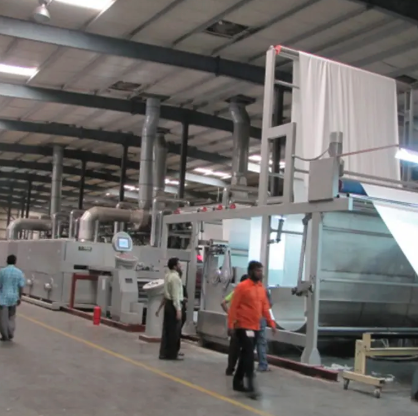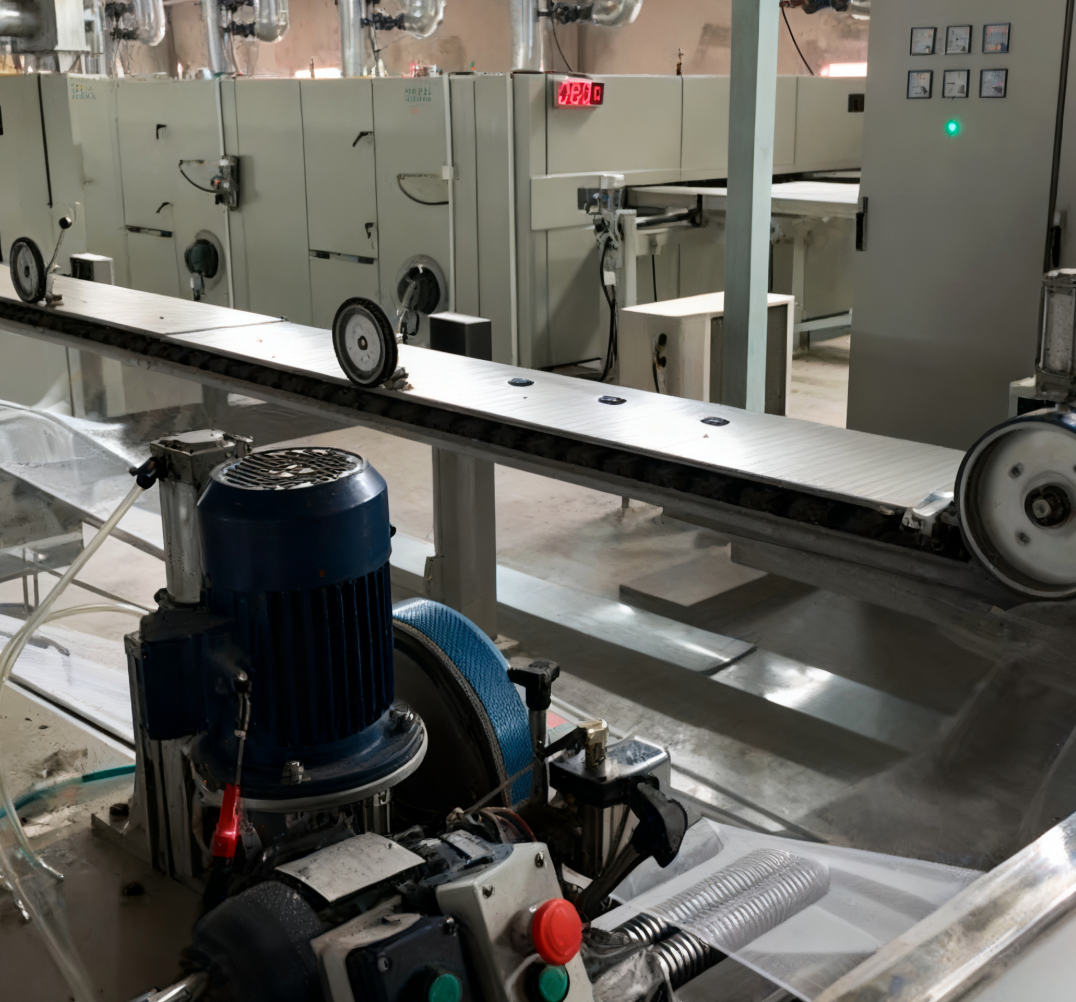Views: 0 Author: Site Editor Publish Time: 2025-10-21 Origin: Site








Textile finishing is the final and critical stage in fabric production, where raw or semi-processed textiles are transformed into high-quality, visually appealing, and functional fabrics. But what machine is used for textile finishing? In modern textile production, a wide range of textile finishing machinery is employed to enhance the appearance, feel, durability, and performance of fabrics. Understanding these machines is essential for manufacturers, designers, and anyone interested in textile production.
Textile finishing is more than just giving fabrics a polished look; it is a combination of mechanical, chemical, and thermal processes that refine the fabric, improve its tactile qualities, and sometimes impart special functionalities such as water repellency, flame resistance, or softness. Different types of fabrics and desired finishes determine the choice of textile finishing machinery, and using the right equipment ensures that the fabrics produced are consistent, high-quality, and ready for the market.

Stenter machines are among the most essential types of textile finishing machinery. They stretch and dry fabrics, ensuring dimensional stability and uniformity. Stenter machines are particularly important for fabrics like cotton, polyester, and blends. By controlling the width and drying speed, these machines enhance the fabric’s texture, appearance, and durability, making them a cornerstone in the finishing process.
Calendering machines are designed to produce a smooth, glossy, and polished finish. They use heated rollers to press the fabric, improving its surface appearance, hand feel, and drape. Fabrics such as silk, satin, and polyester blends benefit greatly from calendering, as it adds a luxurious sheen and makes the textiles more attractive to consumers. Modern calendering machines are also equipped with advanced controls for precise pressure and temperature adjustments.
Mercerizing machines treat cotton fabrics with a caustic soda solution, giving the fabric a lustrous finish, increased strength, and enhanced dye absorption. This type of textile finishing machinery is crucial for cotton textiles intended for garments, home textiles, or decorative applications. The process not only improves appearance but also enhances color vibrancy and long-term durability.
Sueding and brushing machines are used to create a soft, plush surface by raising the fibers and removing loose lint. Sueding imparts a luxurious texture, while brushing machines refine the fabric surface and remove imperfections. These machines are widely used for apparel, home textiles, and specialty fabrics where hand feel is a key quality indicator.
Coating and laminating machines apply functional finishes, such as water repellency, flame retardancy, or anti-static properties. By adding layers or chemical treatments, these textile finishing machinery ensure that fabrics meet performance requirements in technical textiles, outdoor gear, and industrial applications. Coating processes also protect fabrics from environmental damage, extending product life.
Singeing machines remove protruding fibers from the fabric surface, creating a smooth finish and enhancing print quality. Shearing machines trim the fabric surface to a uniform height, producing consistent texture and appearance. Both types of textile finishing machinery are essential for ensuring high-quality surface finishes in apparel, home textiles, and industrial fabrics.
Embroidery and monogramming machines can also be considered part of textile finishing. These machines allow detailed decorative patterns, logos, or initials to be applied to fabrics with precision. Computerized embroidery machines, in particular, are vital for high-quality, repeatable designs, making them indispensable in fashion, home textiles, and personalized products.
| Machine Type | Description | Benefits |
|---|---|---|
| Stenter Machines | Stretch and dry fabrics for dimensional stability and uniformity. | Enhances texture, appearance, and durability of fabrics. |
| Calendering Machines | Produce a smooth, glossy finish using heated rollers. | Adds sheen and improves drape for luxurious textiles. |
| Mercerizing Machines | Treat cotton with caustic soda for luster, strength, and dye absorption. | Improves appearance and durability for cotton textiles. |
| Sueding and Brushing Machines | Create a soft, plush surface by raising fibers and removing lint. | Adds texture and refines fabric surface for better hand feel. |
| Coating and Laminating Machines | Apply functional finishes like water repellency or flame retardancy. | Ensures performance requirements and protects fabrics. |
| Singeing and Shearing Machines | Remove protruding fibers and trim fabric surface for smooth finish. | Essential for high-quality surface finishes in various textiles. |
| Embroidery and Monogramming Machines | Apply decorative patterns or logos to fabrics. | Vital for detailed designs in fashion and personalized products. |
The mechanical processes in textile finishing machinery involve rollers, brushes, or heated surfaces to treat the fabric. These actions smooth out irregularities, compress the fibers for a uniform appearance, or raise fibers to create a soft, plush texture. Mechanical finishing improves the hand feel of the fabric, enhances its visual appeal, and prepares it for further treatments.
Chemical finishing uses specialized solutions or coatings applied to fabrics via textile finishing machinery. These treatments can provide water repellency, flame resistance, anti-staining properties, or additional softness. By incorporating chemical finishes, manufacturers enhance both the functional and aesthetic qualities of the textile, ensuring that the fabric meets specific performance requirements.
Thermal finishing processes set the dimensions of the fabric, stabilize the fiber structure, and refine the surface. Using heated rollers or controlled ovens, textile finishing machinery ensures fabrics maintain their shape, smoothness, and performance during use and after repeated washes. Thermal finishing is particularly important for fabrics like cotton, polyester blends, and delicate synthetics.
Modern textile finishing machinery often integrates automated systems and computerized controls. This technology allows precise regulation of temperature, speed, pressure, and chemical application. Automation ensures consistent quality across large production runs, minimizes material waste, and adapts to different fabric types, thicknesses, and end uses. By combining mechanical, chemical, and thermal finishing into a seamless workflow, manufacturers can achieve high efficiency and superior fabric quality.

Textile finishing machinery produces fabrics that are smooth, polished, and wrinkle-free. Processes like calendering, brushing, and sueding enhance the visual appeal of textiles and create a luxurious, soft hand feel. This makes finished fabrics more attractive for garments, home textiles, and decorative applications.
By reinforcing fibers and stabilizing fabric dimensions, finishing machinery improves the longevity and resilience of textiles. Fabrics become resistant to wear, tear, and deformation, ensuring high-quality performance even under frequent use or repeated washing. This durability is essential for both everyday apparel and industrial or technical textiles.
Advanced textile finishing machinery allows manufacturers to add specific functionalities to fabrics, such as water resistance, flame retardancy, anti-bacterial properties, UV protection, or stain resistance. These functional finishes broaden the range of applications and increase the value and competitiveness of the textiles in the market.
Using modern finishing machinery automates labor-intensive processes, significantly improving production efficiency. Computerized controls ensure that every batch of fabric meets quality standards consistently, while reducing waste and minimizing human error. This efficiency allows manufacturers to scale production without compromising the quality of the finished textiles.
When selecting textile finishing machinery, the type of fabric being processed is a primary consideration. Different fabrics—such as cotton, wool, polyester, silk, or blends—respond differently to mechanical, chemical, or thermal treatments. The desired finish, whether it’s a smooth, glossy surface, soft hand feel, or functional properties like water resistance, must also guide the choice of machinery. Machines are often specialized to handle delicate fabrics without damage or heavy-duty textiles efficiently.
Production scale is another key factor when choosing textile finishing machinery. High-volume operations require machines capable of continuous processing with minimal downtime, while smaller-scale operations may prioritize flexibility and multifunctionality. Manufacturers should evaluate the machine’s throughput, speed, and capacity to ensure it meets production demands without compromising quality or increasing operational costs.
Modern textile finishing machinery comes with a variety of features designed to enhance efficiency and precision. Temperature control, speed adjustments, automated chemical dosing, and computerized process monitoring are all important capabilities. Machines with advanced automation reduce manual labor, minimize errors, and maintain consistent results across large batches, ensuring that the final fabrics meet strict quality standards.
Cost is an important factor, but it should be evaluated alongside long-term value. While advanced textile finishing machinery may require a higher initial investment, the benefits of durability, energy efficiency, reduced waste, and improved production speed often justify the cost. Manufacturers should also consider maintenance requirements, availability of spare parts, and technical support when assessing the overall value of a machine.
| Consideration | Description |
|---|---|
| Assessing Fabric Type and Desired Finish | Consider how different fabrics respond to treatments and the desired finish for the fabric, guiding the choice of machinery. |
| Considering Production Volume and Efficiency | Evaluate machine throughput, speed, and capacity to meet production demands without compromising quality or increasing operational costs. |
| Evaluating Machine Features and Automation | Look for advanced features like temperature control, speed adjustments, automated chemical dosing, and computerized process monitoring for precision. |
| Budget and Long-Term Value Considerations | Weigh the initial investment against the long-term benefits of durability, energy efficiency, reduced waste, and improved production speed. |
A: Textile finishing machinery is used to enhance fabric appearance, feel, durability, and functionality, making textiles market-ready.
A: Common types include stenter, calendering, mercerizing, sueding and brushing, coating and laminating, singeing and shearing, and embroidery machines.
A: Mechanical finishing uses rollers, brushes, or heated surfaces to smooth, compress, or raise fibers for improved texture and appearance.
A: Chemical finishing applies coatings or solutions to add water resistance, flame retardancy, softness, or stain protection.
A: Thermal finishing stabilizes fabric shape, sets fibers, and improves surface smoothness and performance.
At VIROCK Textile Machinery Co., Ltd., we take pride in offering a wide range of advanced textile finishing machineries designed to meet the diverse needs of the modern textile industry. As a leading textile finishing machinery manufacturer, we specialize in equipment that enhances fabric quality, appearance, and functionality.
From stenter machines to calendering, mercerizing, and coating systems, our machines are engineered for precision, efficiency, and durability. We understand the importance of producing textiles that are smooth, durable, and visually appealing, and our textile finishing machinery helps manufacturers achieve consistent, high-quality results every time.
By choosing VIROCK Textile Machinery Co., Ltd., you gain access to cutting-edge technology, reliable performance, and expert support for all your textile finishing needs. Let us help you transform your fabrics into superior products that stand out in the marketplace.